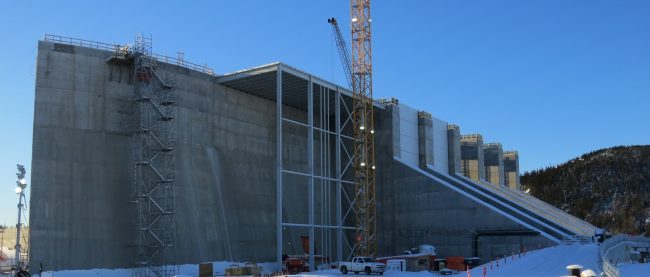
Muskrat Falls protests continue, despite commitment to clear more reservoir land
by Michael MacDonald, The Canadian Press

State-owned utility Nalcor admitted methylmercury levels would rise in reservoir after province ordered it to remove more forest from flood zone

The hydro project’s reservoir requires the flooding of a 45-square-kilometre area in the remote province. PHOTO: Nalcore Energy.
ST. JOHN’S, N.L.—Protesters at the Muskrat Falls hydroelectric project in Labrador were again blocking access to the work site early Oct. 20—preventing workers from reaching the site in violation of an earlier court injunction.
Nine people were arrested earlier this week after Nalcor Energy secured an injunction on Sunday forbidding obstruction of its main entrance. RCMP said they each faced one count of disobeying a court order.
The new blockade comes hours after Nalcor confirmed that methylmercury levels are expected to rise in the reservoir created by construction of the project. Company officials said saying local residents can eventually expect an advisory warning them to limit their consumption of fish.
Shortly before, the provincial government has ordered Crown-owned Nalcor to remove more forest cover from the land that will be flooded to create the 41-square-kilometre reservoir—a process that is expected to begin later this month.
The additional cutting is meant to address the concerns of critics who say the water will be contaminated with unacceptable levels of methylmercury if too many trees are left to rot at the bottom of the reservoir. The neurotoxin is linked to heart issues, intellectual problems in children and other effects.
“For fish in the reservoir, I think we would generally expect levels to rise high enough that we would consider advising people not to eat fish that often,” said Gilbert Bennett, executive vice-president of power development.
“We’re not saying it’s not safe. It’s entirely safe to eat. The only question is, taking appropriate steps to mitigate the risk.”
The project is upstream from 2,000 Inuit in the Lake Melville region who rely on fish and seal meat.
Bennett said similar advisories have been issued for waters adjacent to other hydroelectric projects in the province, and across Canada and the United States.
“We’re in this for the long haul,” he said. “We have a long-term common objective to make sure that the health of everybody is protected.”
Dr. David Allison, the project’s chief medical officer, said the predicted increase in methylmercury levels is comparable to hydroelectric reservoirs in Quebec, which have seen levels increase by three to seven times before falling off over time.
“The process (of methylmercury contamination) is not limited to hydroelectric development,” Bennett said. “The process happens, to varying degrees in wetlands, in lakes and rivers. There you’ll find mercury in fish that is unrelated to any hydroelectric development.”
Removing more trees from the reservoir area would help reduce the amount of methylmercury in the water, but senior biologist Jim McCarthy said removing the soil from the basin would have a much bigger impact.
Bennett said such a move would be unprecedented for a hydro project, though he said Nalcor would look into the feasibility of such a move.
The project is well behind schedule and over budget. Estimated costs have soared to $11.4 billion from $7.4 billion four years ago. First power has been delayed until 2019.
A spillway has been built to divert the lower Churchill River from the site where the dam will be built. Company officials said the reservoir, at 41-square kilometres, will be tiny compared with the existing 2,300-square-kilometre reservoir upriver at the Churchill Falls hydroelectric project.
—With files from VOCM